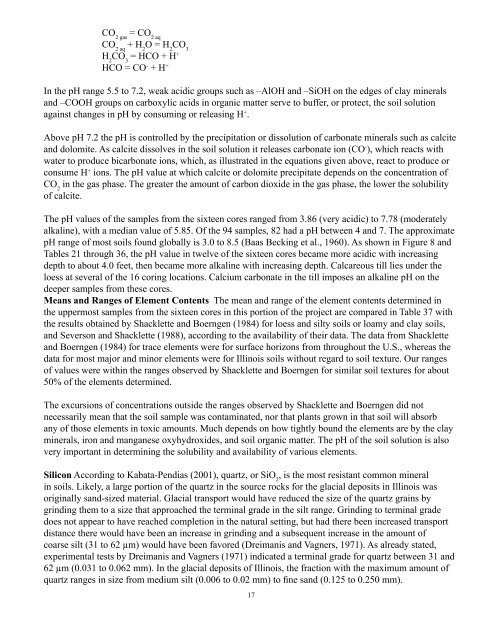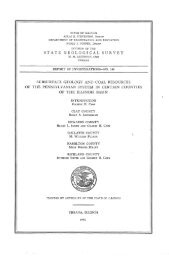cores. In cores 1 <strong>through</strong> 10, however, the correl<strong>at</strong>ion coefficient was only 0.43. On an individual core-<strong>by</strong>corebasis, 16 <strong>of</strong> the total <strong>of</strong> <strong>26</strong> cores had positive correl<strong>at</strong>ion coefficients <strong>of</strong> 0.5 or gre<strong>at</strong>er. This suggeststh<strong>at</strong> there might be a chemical associ<strong>at</strong>ion between Pb and P. Two minerals have been found in soils intrace amounts, pyromorphite [Pb 5(PO 4) 3Cl] and plumbogummite [PbAl 3(PO 4) 2(OH) 5H 2O] (Nriagu, 1974).The correl<strong>at</strong>ion coefficient between Pb and Al was low (0.19) for all <strong>26</strong> cores, so th<strong>at</strong> might rule out anyconsistent occurrence <strong>of</strong> plumbogummite in the soil samples.Zinc was correl<strong>at</strong>ed in the sixteen cores with both Pb (0.65) and P 2O 5(0.57). Zinc phosph<strong>at</strong>e, such as zincpyromorphite [Zn 3(PO 4) 24H 2O] was observed in mine waste soil th<strong>at</strong> had been amended with Na 2HPO 4(Cotter-Howells and Caporn, 1996).Soil pH Soil pH is a measure <strong>of</strong> the acidity or hydrogen ion (H + ) content <strong>of</strong> the soil solution. Varioussubstances are important in maintaining soil pH, depending on the pH range. At pH values between 4.5and 5.5, aluminum in the soil solution, which may origin<strong>at</strong>e from clay minerals, buffers the pH <strong>of</strong> the soilsolution according to the following chemical reactions (Hassett, 1989):Al 3+ + H 2O = AlOH 2+ + H +AlOH 2+ + H 2O = Al(OH) + H +Al(OH) + H 2O = Al(OH) 3s+ H +Al(OH) 3s+ H 2O = Al(OH) + H +If small amounts <strong>of</strong> gibbsite, Al(OH) 3, or clay minerals in the soil dissolve to contribute Al 3+ to the soilsolution, the Al 3+ becomes hydrolyzed to AlOH 2+ , which results in the addition <strong>of</strong> H + to the solution, whichresults in gre<strong>at</strong>er acidity. If additional H + enters the soil solution, the reaction between AlOH 2+ and Al 3+ isdriven to the left and H + is consumed in the form<strong>at</strong>ion <strong>of</strong> H 2O and Al 3+ . Aluminum, therefore, serves as anacidity buffer for pH between values <strong>of</strong> about 4.5 and 5.5 (Sparks, 1995). Above pH 5.5, the solubility <strong>of</strong>Al 3+ is low enough th<strong>at</strong> it is not effective in buffering soil pH.In the pH range <strong>of</strong> 5.5 to 6.8, there are three mechanisms th<strong>at</strong> act to maintain soil solution pH: (1) H + andbasic c<strong>at</strong>ions <strong>of</strong> the soil exchange-complex buffer the pH, (2) <strong>at</strong>mospheric carbon dioxide (CO 2) dissolvesin and reacts with w<strong>at</strong>er, and (3) weak acidic groups <strong>of</strong> soil mineral m<strong>at</strong>ter such as silic<strong>at</strong>e groups <strong>of</strong> clayminerals (for example, smectite) and organic m<strong>at</strong>ter exchange H + with the soil solution. Soil organicm<strong>at</strong>ter is more important than clay minerals in controlling pH and adsorption <strong>of</strong> various c<strong>at</strong>ions in soils(Helling et al., 1964; Yuan et al., 1967)If some external source <strong>of</strong> acid makes the soil solution more acidic, some <strong>of</strong> the H + ions in the soilsolution are adsorbed <strong>by</strong> the soil in exchange for basic c<strong>at</strong>ions, which go into solution. Conversely, ifthe soil solution becomes more alkaline, some <strong>of</strong> the basic c<strong>at</strong>ions become <strong>at</strong>tached to the soil solids inexchange for H + ions, which enter the soil solution and make the solution more acidic. In this way, the soilsolids act to resist change in the pH <strong>of</strong> the soil solution.Atmospheric carbon dioxide (CO 2) contributes to the control <strong>of</strong> soil solution pH <strong>by</strong> reactions with w<strong>at</strong>erto produce carbonic acid and intermedi<strong>at</strong>e carbon<strong>at</strong>e and bicarbon<strong>at</strong>e anions, as in the following reactions(Hassett, 1989):16
CO 2 gas= CO 2 aqCO 2 aq+ H 2O = H 2CO 3H 2CO 3= HCO + H +HCO = CO - + H +In the pH range 5.5 to 7.2, weak acidic groups such as –AlOH and –SiOH on the edges <strong>of</strong> clay mineralsand –COOH groups on carboxylic acids in organic m<strong>at</strong>ter serve to buffer, or protect, the soil solutionagainst changes in pH <strong>by</strong> consuming or releasing H + .Above pH 7.2 the pH is controlled <strong>by</strong> the precipit<strong>at</strong>ion or dissolution <strong>of</strong> carbon<strong>at</strong>e minerals such as calciteand dolomite. As calcite dissolves in the soil solution it releases carbon<strong>at</strong>e ion (CO - ), which reacts withw<strong>at</strong>er to produce bicarbon<strong>at</strong>e ions, which, as illustr<strong>at</strong>ed in the equ<strong>at</strong>ions given above, react to produce orconsume H + ions. The pH value <strong>at</strong> which calcite or dolomite precipit<strong>at</strong>e depends on the concentr<strong>at</strong>ion <strong>of</strong>CO 2in the gas phase. The gre<strong>at</strong>er the amount <strong>of</strong> carbon dioxide in the gas phase, the lower the solubility<strong>of</strong> calcite.The pH values <strong>of</strong> the samples from the sixteen cores ranged from 3.86 (very acidic) to 7.78 (moder<strong>at</strong>elyalkaline), with a median value <strong>of</strong> 5.85. Of the 94 samples, 82 had a pH between 4 and 7. The approxim<strong>at</strong>epH range <strong>of</strong> most soils found globally is 3.0 to 8.5 (Baas Becking et al., 1960). As shown in Figure 8 andTables 21 <strong>through</strong> 36, the pH value in twelve <strong>of</strong> the sixteen cores became more acidic with increasingdepth to about 4.0 feet, then became more alkaline with increasing depth. Calcareous till lies under theloess <strong>at</strong> several <strong>of</strong> the 16 coring loc<strong>at</strong>ions. Calcium carbon<strong>at</strong>e in the till imposes an alkaline pH on thedeeper samples from these cores.Means and Ranges <strong>of</strong> Element Contents The mean and range <strong>of</strong> the element contents determined inthe uppermost samples from the sixteen cores in this portion <strong>of</strong> the project are compared in Table 37 withthe results obtained <strong>by</strong> Shacklette and Boerngen (1984) for loess and silty soils or loamy and clay soils,and Severson and Shacklette (1988), according to the availability <strong>of</strong> their d<strong>at</strong>a. The d<strong>at</strong>a from Shackletteand Boerngen (1984) for trace elements were for surface horizons from <strong>through</strong>out the U.S., whereas thed<strong>at</strong>a for most major and minor elements were for <strong>Illinois</strong> soils without regard to soil texture. Our ranges<strong>of</strong> values were within the ranges observed <strong>by</strong> Shacklette and Boerngen for similar soil textures for about50% <strong>of</strong> the elements determined.The excursions <strong>of</strong> concentr<strong>at</strong>ions outside the ranges observed <strong>by</strong> Shacklette and Boerngen did notnecessarily mean th<strong>at</strong> the soil sample was contamin<strong>at</strong>ed, nor th<strong>at</strong> plants grown in th<strong>at</strong> soil will absorbany <strong>of</strong> those elements in toxic amounts. Much depends on how tightly bound the elements are <strong>by</strong> the clayminerals, iron and manganese oxyhydroxides, and soil organic m<strong>at</strong>ter. The pH <strong>of</strong> the soil solution is alsovery important in determining the solubility and availability <strong>of</strong> various elements.Silicon According to Kab<strong>at</strong>a-Pendias (2001), quartz, or SiO 2, is the most resistant common mineralin soils. Likely, a large portion <strong>of</strong> the quartz in the source rocks for the glacial deposits in <strong>Illinois</strong> wasoriginally sand-sized m<strong>at</strong>erial. Glacial transport would have reduced the size <strong>of</strong> the quartz grains <strong>by</strong>grinding them to a size th<strong>at</strong> approached the terminal grade in the silt range. Grinding to terminal gradedoes not appear to have reached completion in the n<strong>at</strong>ural setting, but had there been increased transportdistance there would have been an increase in grinding and a subsequent increase in the amount <strong>of</strong>coarse silt (31 to 62 µm) would have been favored (<strong>Dr</strong>eimanis and Vagners, 1971). As already st<strong>at</strong>ed,experimental tests <strong>by</strong> <strong>Dr</strong>eimanis and Vagners (1971) indic<strong>at</strong>ed a terminal grade for quartz between 31 and62 µm (0.031 to 0.062 mm). In the glacial deposits <strong>of</strong> <strong>Illinois</strong>, the fraction with the maximum amount <strong>of</strong>quartz ranges in size from medium silt (0.006 to 0.02 mm) to fine sand (0.125 to 0.250 mm).17
- Page 1 and 2: A Progress Report on the Descriptio
- Page 3 and 4: INTRODUCTIONThe Illinois State Geol
- Page 5 and 6: As continental glaciers advanced in
- Page 7 and 8: In areas where the glacial sediment
- Page 9 and 10: the boundary between them. Where su
- Page 11 and 12: Occlusion refers to the physical en
- Page 13 and 14: tungsten carbide grinding capsule t
- Page 15 and 16: RESULTS AND DISCUSSIONSampling Plan
- Page 17: increases also. If the correlation
- Page 21 and 22: Potassium Typically, potassium occu
- Page 23 and 24: on oxides and hydroxides. Fertilize
- Page 25 and 26: For most cores, the Rb content was
- Page 27 and 28: Brady, N. C. and R. R. Weil, 1999,
- Page 29 and 30: Killey, M. M., 1998, Illinois’ Ic
- Page 31 and 32: Table 1. Core number, county name,
- Page 33 and 34: Table 3. Texture of samples from co
- Page 35 and 36: Table 9. Texture of samples from co
- Page 37 and 38: Table 15. Texture of samples from c
- Page 39 and 40: Table 19. Soil texture, soil type,
- Page 41 and 42: Table 20 continued. Correlation coe
- Page 43 and 44: Table 21. Elemental composition of
- Page 45 and 46: Table 23. Elemental composition of
- Page 47 and 48: Table 25. Elemental composition of
- Page 49 and 50: Table 27. Elemental composition of
- Page 51 and 52: Table 29. Elemental composition of
- Page 53 and 54: Table 31. Elemental composition of
- Page 55 and 56: Table 33. Elemental composition of
- Page 57 and 58: Table 35. Elemental composition of
- Page 59 and 60: Table 37. Means and ranges of eleme
- Page 61 and 62: Sample locationFigure 2 Sample loca
- Page 63 and 64: Figure 461
- Page 65 and 66: Figure 6.63
- Page 67 and 68: Figure 8.65
- Page 69 and 70:
Figure 10.67
- Page 71 and 72:
Figure 12.69
- Page 73 and 74:
Figure 14.71
- Page 75 and 76:
Figure 16.73
- Page 77 and 78:
Figure 18.75
- Page 79 and 80:
Figure 20.77
- Page 81 and 82:
Figure 22.79
- Page 83 and 84:
Figure 24.81
- Page 85 and 86:
Figure 26.83
- Page 87 and 88:
Figure 28.85
- Page 89 and 90:
Figure 31.87
- Page 91 and 92:
Figure 33.89
- Page 93 and 94:
Figure 35.91
- Page 95:
Figure 37.93
















